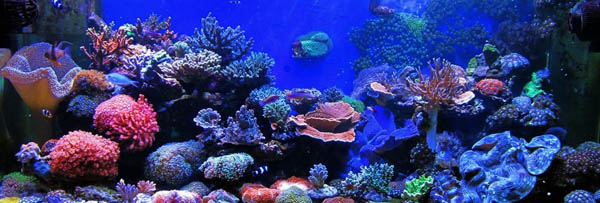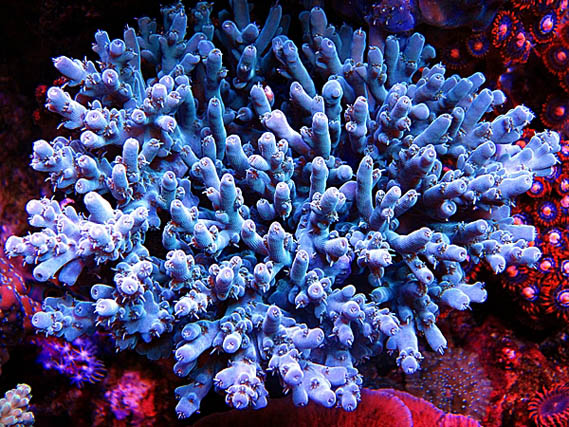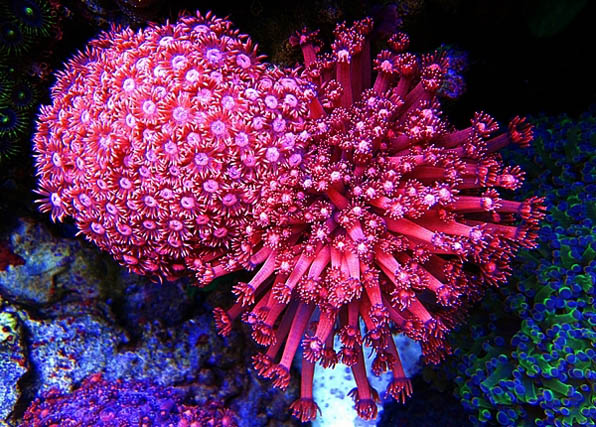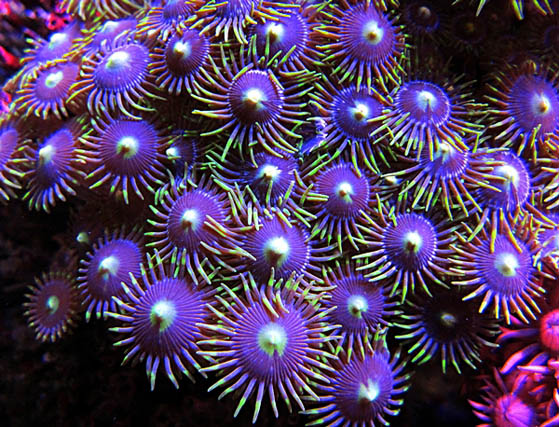 Tank of the Month June 2012
Tank of the Month June 2012
Tank of the Month June 2012
Nano's (Letter2no) 540L Mixed Reef Aquarium
 |
Introduction
Hello everybody! Where should I start? First, let me introduce myself. My name is Nano (letter2no), I’m from Magelang, Indonesia. Magelang is 450km from my capital city, Jakarta and it is located at the foot of Merbabu mountain.
I received notification that I was nominated of Reefkeeping Magazine’s Tank of the Month. It was a surprise to me because I feel there are many tanks better than mine with marvelous equipment. My tank, it is just simple mixed reef aquarium with simple filtration.
Background
My first saltwater aquarium started in 2000 and consisted of a simple glass aquarium that was 80cm in length (31.5in), a hang-on-back filter with filter mats, and a pump in the tank. In the first two weeks, all the fish had died off one by one. After this accident, I collected a lot of information about saltwater aquariums from the internet, books, and friend’s experiences. I remembered that “GARF” was one of the first websites that I searched for information about saltwater aquariums. I found some information as to how to set up the aquarium, and how to propagate corals.
In 2004, I upgraded my aquarium to 150x60x60 cm (59" x 24" x 24") with 8mm thick glass. I had a simple DIY PVC protein skimmer as the main filtration and a 10cm deep sand bed (DSB). I used Bali sand for the sandbed. I used four PL lamps (56watt each) as the main lighting for the tank. In the beginning all of the corals, softies and some LPS, were happy, but after 7 months there were some problems. First, red slime algae grew over the live rock, ontop of the sand, and on the glass. This condition made me frustrated, so I decided to leave this tank with no maintenance other than just adding freshwater to replace evaporation. A few months later in 2008, I realized that some corals could survive with this “hands off” approach and not only grew, but thrived. Based on this, I decided to rebuild the tank with an idea of what I wanted. I wanted simple filtration, no water changes, a lower electricity bill, and good coral growth. Maybe it was a crazy idea, but I want I found is the basis of my current aquarium. It proves that a low maintenance, hands-off method works.
 |
Current Tank
I decided to rebuild the aquarium in September, 2008. In this tank, I used dead rock from my past reef tank and went with a ‘bare bottom’ (no substrate) system that used natural sea water (NSW). I added a single handmade protein skimmer with an 800L needle-wheel pump as my main filtration system and used my old DIY skimmer as a reactor for my bio-balls. In my experience and opinion, this simple filtration setup could handle the bioload that corals produce.
I added some soft corals and some large polyped stony (LPS) corals, as they do not require high lighting. I think these corals are very hardy and could survive new tank syndrome. The corals were more adaptable with the fluctuation of water parameter that could happen during the initial cycling time. In the beginning, I used 2x 150W 6500K metal halide lamps for the lighting. I know this lighting cannot support the coral with ideal PAR for photosynthesis, but at the time these were the only lamps that I could purchase. I was worried that the high wattage of these lamps would produce heat that would be transferred to my tank, and raise my electricity bills. However, a year later I replaced one of the lamps with a 250W 5000K metal halide setup. I used this 5000K lamp for about 6 month, and I noticed that my coral grew faster in this lighting, but it was not producing the color that those corals can display. At the time, it was very expensive for me to buy a new lamp. Especially, a metal halide with a higher Kelvin temperature and so I needed to save. I changed the lamp to BLV 14,000K and the coral slowed down as far as growth while coloring up nicely.
To reduce my electric bill and to increase PAR, I decided to go with LEDs. Nowadays, I use a total of 232 watts of LEDs. The array I have created contains LEDs with 1W, 3W and 5W on the left side of the tank, and on the right side I use 250W Radium 20,000K. I decide to use this combination of lighting to compare the coral growth and their coloration between the two. It has been almost 3 years and 8 months since I have done a water change and all the corals look great.
System Profile
• Display tank: 540L (~140 US gallon) bare bottom glass aquarium (150cm x 60cm x 60cm)
• Sump: 80cm x 40cm x 40cm (128L / 33 US gallons)
• Refugium: 180L / 46 US gallon refugium (100cm x 45cm x 40cm)
• Skimmer: Half cone internal skimmers
• LEDs: 232W DIY Luxeon LEDs with 60° optics on Eaton APR48 PSU (16x 3W Royal Blue, 29x 3W Cool White, 17x 1W Blue, 8x 5W Royal Blue, 8x 5W Cool White)
• Metal Halide: Radium 250W 20,000K contained in Diamond cut reflector using magnetic ballast
• Refugium Lighting: 120W DIY Luxeon LEDs on PSU (24x 1W Blue, 24x 3W White, 8x 3W Blue)
• Return Pump: Atman 105
• Circulation: Tunze 6101 with DIY controller, 2x Jebo Wavemaker
• Other: Rowaphos DIY 4" PVC bio-ball reactor (60cm / 24" tall)
 |
Filtration
The filtration in my tank is very simple, the water from main aquarium flows to first chamber in my sump. This first chamber contains my bio-ball reactor and skimmer. The second chamber contains GROMAX, ceramic rings, and a return pump to the refugium. The third chamber is a place for the return pump to main tank.
I put GROMAX and ceramic rings in the flower pots of the second chamber. GROMAX and ceramic rings are a place for bacteria to convert nutrients in the water. In the second chamber, I used a 50–100mL solution that consist of cultured bacteria. I add this every 2 weeks. I also use a local product containing denitrifying bacteria. Then I tested my system and all parameters were in good order. To support the bacteria population, I use 50–100mL of a carbon source (6 tablespoons of sugar diluted in 1500mL water). Initially, I used bio pellets as a carbon source. I felt that they are a very good way to support present nitrifying bacteria, but I was afraid it would clog something in my tank. So I uninstalled it and went back to sugar dosing. I never added these solutions to any of my previous systems, just this tank.
Water from the second chamber is pumped into my refugium with a Resun King 2. The refugium contains a 10cm DSB, chaetomorpha, mother colonies of many zoanthids, and frags of those zoanthids. The Bali sand (particle size ± 1mm) was used to create a deep sand bed in the refugium. The refugium contains a lot of creatures; amphipods, copepods, spaghetti worms, bristle worms, snails, and sponges. I use freshwater (not RO/DI water) from my home reservoir. I do this because freshwater in my area comes from natural spring water.
 |
Additives
I try to keep my system simplistic. I last changed the water in my aquarium 3 years and 8 months ago. At that time, it was basically as I was setting my current aquarium up in September 2008. Since then I just add freshwater by pouring it into the aquarium. Every two weeks I use a calcium chloride additive to supplement calcium depletion. I also add magnesium chloride, magnesium sulphate, and sodium hydrogen carbonate (baking soda). These additives keep my calcium, alkalinity, and my magnesium at proper levels. Occasionally, I will add Lugols. I also add live marine phytoplankton at times. Check Avon Brochure and Builders Warehouse Specials.
|
Water Parameters:
|
 |
Livestock
|
Fish:
SPS:
LPS:
Soft Corals:
Invertebrates:
|
 |
Acknowledgements
I would like to thank my mother who maintains my aquarium when I am away. She is a wonderful reef-keeper. I also would like to thank my wife and my son for their support. A special thanks to Rocky Ismail who helped me with taking pictures. Thanks also to Triastuti for editing this article, to my reefer community in Indonesia, and to all posters on Reef Central.
Always keep it simple.
Nano (letter2no)
 |
Feel free to comment or ask questions about my tank in the Tank of the Month thread on Reef Central.



